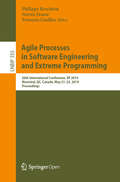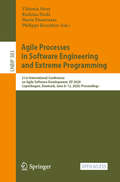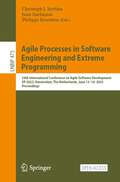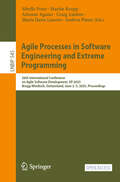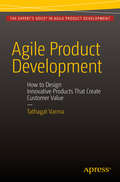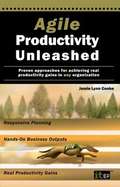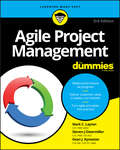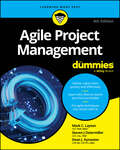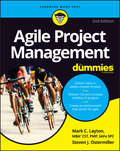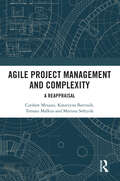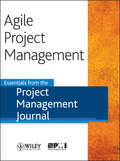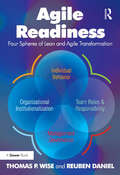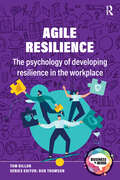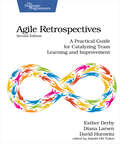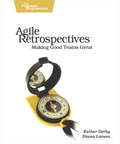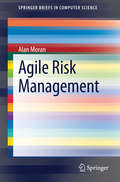- Table View
- List View
Agile Processes in Software Engineering and Extreme Programming: 19th International Conference, XP 2018, Porto, Portugal, May 21–25, 2018, Proceedings (Lecture Notes in Business Information Processing #314)
by Xiaofeng Wang Juan Garbajosa Ademar AguiarThis open access book constitutes the proceedings of the 19th International Conference on Agile Software Development, XP 2018, held in Porto, Portugal, in May 2018. XP is the premier agile software development conference combining research and practice, and XP 2018 provided a playful and informal environment to learn and trigger discussions around its main theme – make, inspect, adapt. The 21 papers presented in this volume were carefully reviewed and selected from 62 submissions. They were organized in topical sections named: agile requirements; agile testing; agile transformation; scaling agile; human-centric agile; and continuous experimentation.
Agile Processes in Software Engineering and Extreme Programming: 20th International Conference, XP 2019, Montréal, QC, Canada, May 21–25, 2019, Proceedings (Lecture Notes in Business Information Processing #355)
by Philippe Kruchten Steven Fraser François CoallierThis open access book constitutes the proceedings of the 20th International Conference on Agile Software Development, XP 2019, held in Montreal, QC, Canada, in May 2019. XP is the premier agile software development conference combining research and practice. It is a hybrid forum where agile researchers, academics, practitioners, thought leaders, coaches, and trainers get together to present and discuss their most recent innovations, research results, experiences, concerns, challenges, and trends. Following this history, for both researchers and seasoned practitioners XP 2019 provided an informal environment to network, share, and discover trends in Agile for the next 20 years The 15 full papers presented in this volume were carefully reviewed and selected from 45 submissions. They were organized in topical sections named: agile adoption, agile practices; large-scale agile; agility beyond IT, and the future of agile.
Agile Processes in Software Engineering and Extreme Programming: 21st International Conference on Agile Software Development, XP 2020, Copenhagen, Denmark, June 8–12, 2020, Proceedings (Lecture Notes in Business Information Processing #383)
by Philippe Kruchten Rashina Hoda Maria Paasivaara Viktoria StrayThis open access book constitutes the proceedings of the 21st International Conference on Agile Software Development, XP 2020, which was planned to be held during June 8-12, 2020, at the IT University of Copenhagen, Denmark. However, due to the COVID-19 pandemic the conference was postponed until an undetermined date.XP is the premier agile software development conference combining research and practice. It is a hybrid forum where agile researchers, academics, practitioners, thought leaders, coaches, and trainers get together to present and discuss their most recent innovations, research results, experiences, concerns, challenges, and trends. Following this history, for both researchers and seasoned practitioners XP 2020 provided an informal environment to network, share, and discover trends in Agile for the next 20 years. The 14 full and 2 short papers presented in this volume were carefully reviewed and selected from 37 submissions. They were organized in topical sections named: agile adoption; agile practices; large-scale agile; the business of agile; and agile and testing.
Agile Processes in Software Engineering and Extreme Programming: 22nd International Conference on Agile Software Development, XP 2021, Virtual Event, June 14–18, 2021, Proceedings (Lecture Notes in Business Information Processing #419)
by Xiaofeng Wang Peggy Gregory Philippe Kruchten Casper LasseniusThis open access book constitutes the proceedings of the 22nd International Conference on Agile Software Development, XP 2021, which was held virtually during June 14-18, 2021.XP is the premier agile software development conference combining research and practice. It is a unique forum where agile researchers, practitioners, thought leaders, coaches, and trainers get together to present and discuss their most recent innovations, research results, experiences, concerns, challenges, and trends. XP conferences provide an informal environment to learn and trigger discussions and welcome both people new to agile and seasoned agile practitioners. This year’s conference was held with the theme “Agile Turns Twenty While the World Goes Online”. The 11 full and 2 short papers presented in this volume were carefully reviewed and selected from 38 submissions. They were organized in topical sections named: agile practices; process assessment; large-scale agile; and short contributions.
Agile Processes in Software Engineering and Extreme Programming: 23rd International Conference on Agile Software Development, XP 2022, Copenhagen, Denmark, June 13–17, 2022, Proceedings (Lecture Notes in Business Information Processing #445)
by Klaas-Jan Stol Philippe Kruchten Maria Paasivaara Viktoria StrayThis open access book constitutes the proceedings of the 23rd International Conference on Agile Software Development, XP 2022, which was held in Copenhagen, Denmark, in June 2022. XP is the premier agile software development conference combining research and practice. It is a unique forum where agile researchers, practitioners, thought leaders, coaches, and trainers get together to present and discuss their most recent innovations, research results, experiences, concerns, challenges, and trends. XP conferences provide an informal environment to learn and trigger discussions and welcome both people new to agile and seasoned agile practitioners. This year’s conference was held with the theme “Agile in the Era of Hybrid Work”. The 13 full papers and 1 short paper presented in this volume were carefully reviewed and selected from 40 submissions. They were organized in topical sections named: agile practices; agile processes; and agile in the large.
Agile Processes in Software Engineering and Extreme Programming: 24th International Conference on Agile Software Development, XP 2023, Amsterdam, The Netherlands, June 13–16, 2023, Proceedings (Lecture Notes in Business Information Processing #475)
by Juan Garbajosa Philippe Kruchten Christoph J. StettinaThis open access book constitutes the proceedings of the 24th International Conference on Agile Software Development, XP 2023, which took place in Amsterdam, The Netherlands, during June 13-16, 2023. XP is the premier agile software development conference combining research and practice. It is a unique forum where agile researchers, practitioners, thought leaders, coaches, and trainers get together to present and discuss their most recent innovations, research results, experiences, concerns, challenges, and trends. XP conferences provide an informal environment to learn and trigger discussions and welcome both people new to agile and seasoned agile practitioners. This year’s conference was held with the theme “Whole Team Sustainability”. The 11 full papers and 1 short paper presented in this volume were carefully reviewed and selected from 40 submissions. They focus on agile practices and agile in the large.
Agile Processes in Software Engineering and Extreme Programming: 25th International Conference on Agile Software Development, XP 2024, Bozen-Bolzano, Italy, June 4–7, 2024, Proceedings (Lecture Notes in Business Information Processing #512)
by Xiaofeng Wang Peggy Gregory Eduardo Guerra Michele Marchesi Darja ŠmiteThis open access book constitutes the proceedings of the 25th International Conference on Agile Software Development, XP 2024, which took place in Bozen-Bolzano, Italy, during June 04-07, 2024. XP is the premier agile software development conference combining research and practice. It is a unique forum where agile researchers, practitioners, thought leaders, coaches, and trainers get together to present and discuss their most recent innovations, research results, experiences, concerns, challenges, and trends. XP conferences provide an informal environment to learn and trigger discussions and welcome both people new to agile and seasoned agile practitioners. This year’s conference was held with the theme “Reflect, Adapt, Envision”. The 10 full and 2 short papers included in these proceedings were carefully reviewed and selected from 32 submissions. They were organized in topical sections as follows: agile at scale; value and quality in agile; and people and teams in agile.
Agile Processes in Software Engineering and Extreme Programming: 26th International Conference on Agile Software Development, XP 2025, Brugg-Windisch, Switzerland, June 2–5, 2025, Proceedings (Lecture Notes in Business Information Processing #545)
by Craig Anslow Ademar Aguiar Maria Ilaria Lunesu Andrea Pinna Sibylle Peter Martin KroppThis open access book constitutes the proceedings of the 26th International Conference on Agile Software Development, XP 2025, which took place in Brugg-Windisch, Switzerland, during June 2-5, 2025. XP is the premier agile software development conference combining research and practice. It is a unique forum where agile researchers, practitioners, thought leaders, coaches, and trainers get together to present and discuss their most recent innovations, research results, experiences, concerns, challenges, and trends. XP conferences provide an informal environment to learn and trigger discussions and welcome both people new to agile and seasoned agile practitioners. The theme for 2025 was "Adapt - Uncovering better ways to deliver valuable software products". The 13 full papers and 4 short papers included in the proceedings were carefully reviewed and selected from 46 submissions. They were organized in topical sections as follows: Leadership and culture; business agility; engineering; and product and design.
Agile Product Development: How to Design Innovative Products That Create Customer Value
by Tathagat VarmaDiscover what it takes to develop products that blow your users away--and take market share from your competitors. This book will explain how the principles behind agile product development help designers, developers, architects, and product managers create awesome products; and how to look beyond a shiny user interface to build a great product. Most importantly, this book will give you a shared framework for your product development team to collaborate effectively. Product development involves several key activities--including ideation, discovery, design, development, and delivery--and yet too many companies and innovators focus on just a few of them much to the detriment of the product's success in the marketplace. As a result we still continue to see high failure rates in new product development, be it inside organizations or startups. Unfortunately, or rather fortunately, these failures are largely avoidable. In the last fifteen years, advances in agile software development, lean product development, human-centered design, design thinking, lean startups and product delivery have helped improve individual aspects of product development. However, not enough guidance has been available to integrate them in the context of the product development life cycle. Until now. Product developer extraordinaire Tathagat Varma in Agile Product Development integrates individual knowledge areas into a field manual for product developers. Organized in the way an idea germinates, sprouts, and grows, the book synthesizes the body of knowledge in a pragmatic way that is more natural to the entire product creation process rather than from individual practices that constitute it. In today's hyper-innovative world, being first to the market, or delivering feature-loaded products, or even offering the latest technology doesn't guarantee success anymore. Sure, those elements are all needed in the right measures, but they are not sufficient by themselves. And getting it right couldn't be more important: Building products that deliver awesome user experiences is the top challenge facing businesses today, especially in a post-Apple world where user experience and design has been elevated to a cult status. What you'll learn How to stimulate creativity and prioritization of ideas in product design How to get early feedback on initial product idea iterations How to design and develop products using sound engineering practices How to apply principles of agility into software delivery Who this book is for Entrepreneurs, designers, developers, product managers, software architects. Table of Contents Chapter 1: Preamble Chapter 2: Discover Chapter 3: Deliberate Chapter 4: Describe Chapter 5: Design Chapter 6: Develop Chapter 7: Deliver
Agile Product and Project Management: A Step-by-Step Guide to Building the Right Products Right
by Mariya BreyterUse this comprehensive Agile product and project management guide with real-world case studies and examples for self-learning or as a student textbook. Whether you are a CEO or a student, this book will take you from Agile delivery to team topology and product-market fit.Agile delivery is becoming a mainstream project management framework, increasing demand for an understanding of modern related concepts. Agile Product and Project Management covers IT delivery and project management basics while approaching IT as a customer-centric product delivery ecosystem. The book covers two major topics: building the RIGHT product and building the product RIGHT. Each chapter builds on the materials in the previous chapter. Terminology and exercises are introduced sequentially. The book takes you on a journey from identifying a product using Agile principles to delivering and iterating on this process, step-by-step. The final chapter provides practical advice on role-based interviews, career progression, professional certifications and affiliations, and communities of practice. You’ll Learn The Objectives and Key Results (OKR) framework, which explains why every project has to align with organizational objectives and how these objectives are used to measure project successAgile (Scrum, Kanban, XP), Waterfall, and hybrid product and project management practices, and how to apply the "working backwards" framework from the customer to IT projectsThe Lean Startup framework of product design, based on the "build-measure-learn" feedback loop, and compared with Waterfall requirements gathering and project scope managementDesign Thinking and customer research practicesThe product backlog taxonomy (epic, user story, subtask, bug, etc.), prioritization techniques, ongoing backlog maintenance, and stakeholder communicationMajor aspects of IT delivery, including Agile teams, roles, frameworks, and success criteriaWaterfall planning and Scrum, in detail, including its Sprint structure, artifacts, roles, and ceremonies (meetings) as well as a comparison of Agile scaling frameworksCase studies of modern technology leaders, from startups to FAANGExamples of release plans and delivery reports based on actual projects in a wide range of companies, ways to minimize technical debt, implement DevOps, and establish quality management practices for software productsEffective ways of managing dependencies and delivering products that delight customers and made the Silicon Valley giants successful and allowed for rapid business growth Who This Book Is ForGraduate students specializing in computer science, information systems, project management, and related management areas; practitioners seeking professional development; and project management professionals looking to grow their careers into Agile product and project management
Agile Productivity Unleashed
by Jamie Lynn CookeAgile Principles Unleashed: Proven approaches for achieving real productivity gains in any organisationAn essential tool for anyone whose job it is to deliver high quality results on time and to budget! Agile approaches are business practices with a proven track record for helping organisations achieve greater efficiency, higher quality outputs and increased customer satisfaction. They enable organisations to avoid the trappings of extensive up-front planning and up-front budget commitments by encouraging staff to regularly produce high quality business outputs; and by basing ongoing financial and resource commitments on the delivered outcomes. This focus on responsive planning based on tangible outputs is why Agile approaches have been successfully used in selected industries for over two decades. Agile Principles Unleashed: Proven approaches for achieving real productivity gains in any organisation introduces every industry sector to the Agile approaches that have dramatically improved the IT, product development and manufacturing sectors over the past two decades. The book clearly explains how the key principles of Agile approaches can be used to significantly increase productivity, quality and customer satisfaction in any organisation. Written in non-technical language specifically for business professionals, this book is an essential tool for anyone whose job it is to deliver high quality results on time and to budget. Benefits of introducing Agile . . . * Minimise waste If a project is heavily planned in advance, but its results are only tested after the work has been completed, then any flaw will be very expensive to put right. Instead, Agile approaches promote stakeholder engagement, and encourage feedback at successive stages of the development process. This means that problems can be detected earlier on, and put right at a much lower cost to the organisation. * Improve communication No matter how precise the blueprint, it is never going to be a substitute for the close co-operation between people of different skills that is required to bring a project to fruition. This book shows you how to achieve results that are aligned with business needs by keeping the technical team in close contact with the business area as the project progresses. * Empower the team Agile approaches allow a delivery team to determine the volume of work that they are capable of delivering within the individual phases of a project. In this way, delivery teams are given a sense of responsibility for completing the assignment within the timeframe they have set themselves, and feel motivated to deliver work of a quality that will continue to satisfy the stakeholders. * Meet deadlines Agile is designed to avoid the business risks involved in 'all-at-once' delivery, where a glitch during one stage of the project throws the entire effort out of kilter, and results in serious delays in completion. This book shows how you can accommodate inevitable internal and external changes through responsive planning. By following Agile principles, staff members no longer have to wait several weeks or months for an updated plan to be agreed, but can quickly adjust their working in line with the new priorities. In this way, Agile will help you to avoid project overrun and to make good your commitments. Over the past two decades, Agile approaches have had a revolutionary impact on software development in many small- and medium-sized IT companies, as well as big corporations like Microsoft, Yahoo! and Google. Thanks to their focus on responsive planning and tangible outputs, Agile approaches have also led to dramatic improvements in the product development and manufacturing sectors. Agile Principles Unleashed presents common-sense methods that will help your organisation to complete projects faster and to a higher standard.
Agile Project Management For Dummies
by Mark C. Layton Steven J. Ostermiller Dean J. KynastonThis updated edition shows you how to use the agile project management framework for success! Learn how to apply agile concepts to your projects. This fully updated book covers changes to agile approaches and new information related to the methods of managing an agile project. Agile Project Management For Dummies, 3rd Edition gives product developers and other project leaders the tools they need for a successful project. This book’s principles and techniques will guide you in creating a product roadmap, self-correcting iterations of deployable products, and preparing for a product launch. Agile approaches are critical for achieving fast and flexible product development. It’s also a useful tool for managing a range of business projects. Written by one of the original agile technique thought-leaders, this book guides you and your teams in discovering why agile techniques work and how to create an effective agile environment. Users will gain the knowledge to improve various areas of project management. Define your product’s vision and features Learn the steps for putting agile techniques into action Manage the project’s scope and procurement Plan your team’s sprints and releases Simplify reporting related to the project Agile Project Management For Dummies can help you to better manage the scope of your project as well as its time demands and costs. You’ll also be prepared to skillfully handle team dynamics, quality challenges, and risks.
Agile Project Management For Dummies
by Mark C. Layton Steven J. Ostermiller Dean J. KynastonPut agile techniques into practice to boost your efficiency and effectiveness Agile Project Management For Dummies introduces you to the planning and execution approaches that can help you complete projects more quickly, with higher quality and using fewer resources. For companies in any industry—not just software development—agile project management reduces waste and increases transparency, while addressing customers' ever-changing requirements. This book lays out the principles and practices of agile techniques in jargon-free language that anyone can understand. You'll learn all the important terms, tools, and concepts, so you can infuse agility into your projects right away. Create a product roadmap and prepare for product launches with ease, thanks to this Dummies guide. Discover why agile techniques are so popular with many of the world's most successful businesses Use agile principles to manage the scope, time, cost, team dynamics, quality, and risk of any project Learn how Inclusion makes organizations more agile, and create an agile-friendly culture of flexibility and productivity within your team and organization Explore how the agile world is changing with new developments like artificial intelligence Agile Project Management For Dummies is great for project and product managers, as well as anyone in any industry who wants get up to speed on how to be more agile.
Agile Project Management For Dummies
by Mark C. Layton Steven J. OstermillerFlex your project management muscle Agile project management is a fast and flexible approach to managing all projects, not just software development. By learning the principles and techniques in this book, you'll be able to create a product roadmap, schedule projects, and prepare for product launches with the ease of Agile software developers. You'll discover how to manage scope, time, and cost, as well as team dynamics, quality, and risk of every project. As mobile and web technologies continue to evolve rapidly, there is added pressure to develop and implement software projects in weeks instead of months—and Agile Project Management For Dummies can help you do just that. Providing a simple, step-by-step guide to Agile project management approaches, tools, and techniques, it shows product and project managers how to complete and implement projects more quickly than ever. Complete projects in weeks instead of months Reduce risk and leverage core benefits for projects Turn Agile theory into practice for all industries Effectively create an Agile environment Get ready to grasp and apply Agile principles for faster, more accurate development.
Agile Project Management and Complexity: A Reappraisal
by Czesław Mesjasz Katarzyna Bartusik Tomasz Małkus Mariusz SołtysikThis research monograph presents an inter-disciplinary study into the impact, and current status, of applications of complexity-related concepts in the early stages of development of agile project management (APM). The results serve as an introduction for exploring more profound relations between complexity-related ideas and APM in the future. The increasing complexity of software projects and their environment in the 1990s constituted the main determinants of the development of the family of methodological frameworks called Agile Project Management. Development of the APM has been shaped by a broadly defined area of research called complexity science or complexity theory based on Complex Adaptive Systems (CAS) and on their characteristics: complexity, chaos, the edge of chaos, emerging properties, non-linearity, self-organization, etc. In the 21st Century, due to the expansion of Agile beyond software development, the challenges deriving from the complexity of projects and the environment are even more actual. Such phenomena demand more profound inter- and multi-disciplinary studies. This book examines the impact of applications of complexity-related ideas deriving from intuitive complexity and from complexity science in the early stages of development of the Agile methodological frameworks in project management and considers the current status of those applications. It questions the usefulness of those applications for practice and theory of APM, and then proposes a conceptual framework for further theoretical studies and several ways of improvement and refinement of the APM necessary to deal with broadly defined complexity in project management. Requiring a medium-level knowledge of complexity studies and knowledge of project management, this book is written for the research community studying the links between the various methodological frameworks included in the APM and complexity-related ideas. It will also be interesting for studies of the impact of complexity on modern management, and for Master's students on IT and management courses.
Agile Project Management with Azure DevOps: Concepts, Templates, and Metrics
by Joachim RossbergRoll up your sleeves and jump into Agile project management to use and customize Microsoft Azure DevOps. Organizations adopt Agile practices because they are a key enabler to run better projects, get more successful end results, and achieve an overall higher quality output. To benefit the most from Agile, you need an Application Life Cycle Management (ALM) or DevOps toolset that supports your style and work environment. Agile Project Management with Azure DevOps teaches you how to use Azure DevOps to implement many Agile practices such as SAFe, Scrum, and Kanban, and it shows you how they fit into a well-planned Agile implementation. Agile product owners will learn how to work with Azure DevOps to set up a project from scratch, and to continue using Azure DevOps throughout. Keeping track of progress is important in any project. Author Joachim Rossberg teaches you about the tools in Azure DevOps that can help you track progress and key metrics, including those that are available right out of the box. You will learn how to create and refine the backlog, work with Kanban and Scrum task boards, and get exposed to valuable key concepts along the way. Finally, you will dive into Azure DevOps extensibility to learn about the many ways you can customize reporting to best meet your needsWhat You'll LearnUnderstand Agile product management concepts and processes for working with Azure DevOps Discover how Azure DevOps supports agile processes end-to-endImplement Agile processes in Azure DevOpsCustomize Azure DevOps to better support your processesComplete step-by-step setup of an Agile project from scratch and manage it through its life cycleWho This Book Is ForSoftware product owners, Agile leaders, Scrum masters, and software engineers who use Microsoft Azure DevOps. A basic understanding of Agile is helpful.
Agile Project Management: Essentials from the Project Management Journal (Project Management Journal)
by Project Management JournalThe development of the Agile Movement, whatever the area of application or discipline, comes from the famous “faster, cheaper, better" maxim. As such, the agile manufacturing paradigm rests on four principles: response to change and uncertainty, supplying highly customized products, synthesis of diverse technologies, and intra-enterprise and inter-enterprise integration. For the reader interested in agile project management applications, response to changes, and transformations and its impact on managing projects, this book is a must-read. Various insights are covered, including: how to master complexity and changes in projects, economy, and society; how interaction between the project management team and project owners can influence risk management; how to move beyond the traditional mechanistic project management approach; how to include agile principles into an improved Logical Framework Analysis structure; what the impact is of agile principles on project management organizations what kind of innovative project management practice supports agile principles; and much more.
Agile Project Management: Managing For Success
by James A. Crowder Shelli FriessManagement and enables them to deal with the demands and complexities of modern, agile systems/software/hardware development teams. The book examines the project/program manager beyond the concepts of leadership and aims to connect to employees' sense of identity. The text examines human psychological concepts such as "locus of control," which will help the manager understand their team members' view and how best to manage their "world" contributions. The authors cover new management tools and philosophies for agile systems/software/hardware development teams, with a specific focus on how this relates to engineering and computer science. This book also includes practical case studies. Discusses management skills needed as they relate to the advances in software development practices Examines how to manage an agile development team that includes teams across geographically, ethnically, and culturally diverse backgrounds Embraces all of the aspects of modern management and leadership
Agile Prozesse – Agile Teams
by Eckhart HanserDas Buch beschreibt kurz und prägnant die aktuellen agilen Prozessmodelle der Software-Entwicklung. Nach einer kurzen Einführung in die historische Entwicklung werden, ausgehend vom Agilen Manifest und den ersten agilen Modellen Extreme Programming (XP) und Crystal, aktuelle Vertreter wie Scrum, Kanban und DevOps näher beleuchtet. Dabei stehen Ablauf des Prozesses, Teamrollen und Artefakte im Vordergrund. Im studentischen Labor des Kompetenzzentrums für agile IT-Prozesse der Dualen Hochschule Baden Württemberg Lörrach werden die diskutierten Prozessmodelle auf ihre „Alltagstauglichkeit“ überprüft. Welche agilen Praktiken sind problemlos, welche stoßen auf Ablehnung der Teammitglieder? Ausgehend von diesen Erfahrungen wird der Teamprozess beleuchtet, insbesondere die Bildung von „Mini-Teams“, der kleinsten Produktiveinheit im Entwicklungsteam. Für den Erfolg eines Projekts unerlässliche Teamrollen werden identifiziert und im „Meta Agile Process Model“ (MAP) formuliert. Ausgehend von der „Karte der Verhaltensweisen“ im Team wird eine Methode zur optimalen Teambildung vorgeschlagen.
Agile Prozesse: [von Xp Über Scrum Bis Map (eXamen.press)
by Eckhart HanserDas Buch beschäftigt sich mit aktuellen agilen Prozessmodellen der Software-Entwicklung. Der Autor stellt prominente Vertreter wie Extreme Programming, Crystal, Crystal Clear und Scrum vor. Dabei stehen Ablauf, Produktrollen und Artefakte im Vordergrund. Ausgehend von Erfahrungen mit agilen Techniken im studentischen Entwicklungslabor wird der Teamprozess beleuchtet, insbesondere die Bildung von Mini-Teams. Die für den Erfolg eines Projekts unerlässlichen Teamrollen werden identifiziert und eine Methode zur optimalen Teambildung vorgeschlagen.
Agile Readiness: Four Spheres of Lean and Agile Transformation
by Thomas P. Wise Reuben DanielAgile Readiness is designed to provide guidance to the manager or business leader in establishing a successful environment to enable fast moving agile and lean project methods focused on business systems transformation. Agile and lean offer huge potential as methods for reducing risk and costs, delivering early benefits and ensuring IT projects genuinely deliver the business transformation benefits that they promise at the outset. The conundrum for many organizations is that without a change of organizational culture, agile and lean methods are very unlikely to be adopted successfully in traditional organizations. Thus, the struggle that many (if not most) managers and executives face is not in how agile or lean development works, but in how to make agile and lean methods successful when working beyond software development. Thomas P. Wise and Reuben Daniel provide a clear view of the struggles and remedies. Their text uses simple ground floor experiences to illustrate the practices and behaviors necessary to create highly successful and effective agile and lean business systems transformation teams. In this book the reader will discover organizational strategies that build strong teams, an environment of trust, and project selection and planning strategies to create an environment of enablement in which agile and lean teams thrive.
Agile Resilience: The psychology of developing resilience in the workplace (Business in Mind)
by Tom DillonFinalist in the Wellness and Wellbeing Category of the Business Book Awards 2023. Everything you need for strengthening and flexing your resilience muscle!Resilience can mean something different to everyone, yet it is increasingly necessary to survive in the modern workspace, whether that is at home, in an office or other place of work. Hard times for organisations generally mean harder times for employees, often with increased workloads and reduced resources. Being able to navigate this environment and remain resilient is preferable, but when stress and anxiety take over you need to know how to boost your resilience and look after your own well-being. An essential read for anyone working today, this book focuses on the concept of agile resilience, exploring how resilience can be learned, chosen, developed and adapted to help you cope with the range of circumstances and experiences you may face. It explains what resilience is, including your own personal take on that, what might deplete it, the impact of Covid-19, and how you can maintain or replenish it when necessary in order to thrive in your work and life.
Agile Retrospectives, Second Edition
by David Horowitz Esther Derby Diana LarsenIn an uncertain and complex world, learning is more important than ever before. In fact, it can be a competitive advantage. Teams and organizations that learn rapidly deliver greater customer value faster and more reliably. Furthermore, those teams are more engaged, more productive, and more satisfied. The most effective way to enable teams to learn is by holding regular retrospectives. Unfortunately, many teams only get shallow results from their retrospectives. This book is filled with practical advice, techniques, and real-life examples that will take retrospectives to the next level--whether your team is co-located, hybrid, or remote. This book will help team leads, scrum masters, and coaches engage their teams to learn, improve, and deliver greater results. For nearly two decades, scrum masters, team leads, and coaches have relied on the first edition of Agile Retrospectivesas an essential resource to facilitate better retrospectives. This edition builds on recent research, reflects the authors' experiences over two decades, and shares wisdom gleaned from the global retrospective community. Find practical advice to level up retrospective skills. Address the challenges of remote and hybrid retrospectives head on. Take advantage of expanded guidance on designing and facilitating retrospectives--based on the questions and concerns of practitioners worldwide. Gain insight into choosing a broad or narrow focus for retrospectives. Explore how to use both objective and subjective data to enable more effective conversations. Learn how to make decisions that stick. Understand the importance of psychological safety and how to foster it in retrospectives. Elevate issues and engage managers in systemic change. Learn from many real-life stories that demonstrate how our advice has impacted retrospectives at organizations around the globe. Finally, find a set of recommended flows that reveal the authors' thought process in designing retrospectives for scenarios teams faced in real life.
Agile Retrospectives: Making Good Teams Great (Pragmatic Programmers)
by Ken Schwaber Esther Derby Diana LarsenProject retrospectives help teams examine what went right and what went wrong on a project. But traditionally, retrospectives (also known as “post-mortems”) are only held at the end of the project—too late to help. You need agile retrospectives that are iterative and incremental. You need to accurately find and fix problems to help the team today. Now Esther and Diana show you the tools, tricks and tips you need to fix the problems you face on a software development project on an on-going basis. You’ll see how to architect retrospectives in general, how to design them specifically for your team and organization, how to run them effectively, how to make the needed changes and how to scale these techniques up. You’ll learn how to deal with problems, and implement solutions effectively throughout the project—not just at the end. This book will help you: Design and run effective retrospectivesLearn how to find and fix problemsFind and reinforce team strengthsAddress people issues as well as technologicalUse tools and recipes proven in the real world With regular tune-ups, your team will hum like a precise, world-class orchestra.
Agile Risk Management (SpringerBriefs in Computer Science)
by Alan MoranThis work is the definitive guide for IT managers and agile practitioners. It elucidates the principles of agile risk management and how these relate to individual projects. Explained in clear and concise terms, this synthesis of project risk management and agile techniques is illustrated using the major methodologies such as XP, Scrum and DSDM. Although the agile community frequently cites risk management, research suggests that risk is often narrowly defined and, at best, implicitly treated, which in turn leads to an inability to make informed decisions concerning risk and reward and a poor understanding of when to engage in risk-related activities. Moreover, the absence of reference to enterprise risk management means that project managers are unable to clearly articulate scope or tailor their projects in line with the wider expectations of the organisation. Yet the agile approach, with its rich toolset of techniques, is very well equipped to effectively and efficiently deal with the risks that arise in projects. Alan Moran addresses the above issues by proposing an agile risk-management process derived from classical risk management but adapted to the circumstances of agile projects. Though his main focus is on the software development process, much of what he describes could be applied to other types of IT projects as well. This book is intended for anyone who is serious about balancing risk and reward in the pursuit of value for their stakeholders, and in particular for those directly involved in agile software development who share a concern for how risk should be managed. Whilst a thorough background in risk management is not presumed, a basic level of familiarity with or exposure to agility is helpful.

